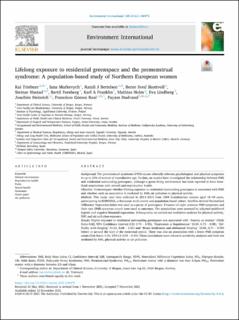| dc.contributor.author | Triebner, Kai Philipp | |
| dc.contributor.author | Markevych, Iana | |
| dc.contributor.author | Bertelsen, Randi Jacobsen | |
| dc.contributor.author | Skottvoll, Bente Sved | |
| dc.contributor.author | Hustad, Simon Steinar | |
| dc.contributor.author | Forsberg, Bertil | |
| dc.contributor.author | Franklin, Karl A | |
| dc.contributor.author | Holm, Mathias | |
| dc.contributor.author | Lindberg, Eva | |
| dc.contributor.author | Heinrich, Joachim | |
| dc.contributor.author | Real, Francisco Gomez | |
| dc.contributor.author | Dadvand, Payam | |
| dc.date.accessioned | 2022-08-11T08:07:15Z | |
| dc.date.available | 2022-08-11T08:07:15Z | |
| dc.date.created | 2022-05-06T12:52:07Z | |
| dc.date.issued | 2022 | |
| dc.identifier.issn | 0160-4120 | |
| dc.identifier.uri | https://hdl.handle.net/11250/3011218 | |
| dc.description.abstract | Background: The premenstrual syndrome (PMS) causes clinically relevant psychological and physical symptoms in up to 20% of women of reproductive age. To date, no studies have investigated the relationship between PMS and residential surrounding greenspace, although a green living environment has been reported to have beneficial associations with overall and reproductive health.
Objective: To investigate whether lifelong exposure to residential surrounding greenspace is associated with PMS and whether such an association is mediated by BMI, air pollution or physical activity.
Methods: This study used data collected in 2013–2015 from 1069 Scandinavian women aged 18–49 years, participating in RHINESSA, a European multi-centre and population-based cohort. Satellite-derived Normalised Difference Vegetation Index was used as a proxy of greenspace. Presence of eight common PMS symptoms and their sum (PMS symptom count) were used as outcomes. The associations were assessed by adjusted multilevel logistic and negative binomial regressions. Subsequently we carried out mediation analyses for physical activity, BMI and air pollution exposure.
Results: Higher exposure to residential surrounding greenspace was associated with “Anxiety or tension” (Odds Ratio 0.82, 95% Confidence Interval (CI): 0.70 – 0.95), ”Depression or hopelessness” (0.84, 0.73 – 0.98), “Difficulty with sleeping” (0.82, 0.68 – 1.00) and “Breast tenderness and abdominal bloating” (0.84, 0.71 – 0.99) before or around the start of the menstrual period. There was also an association with a lower PMS symptom count (Risk Ratio: 0.94, 95% CI: 0.91 – 0.99). These associations were robust to sensitivity analyses and were not mediated by BMI, physical activity or air pollution.
Conclusions: Living in greener areas may be beneficial against PMS symptoms. Further studies are needed to confirm these novel findings and to explore the underlying biological mechanisms. | en_US |
| dc.language.iso | eng | en_US |
| dc.publisher | Elsevier | en_US |
| dc.rights | Navngivelse 4.0 Internasjonal | * |
| dc.rights.uri | http://creativecommons.org/licenses/by/4.0/deed.no | * |
| dc.title | Lifelong exposure to residential greenspace and the premenstrual syndrome: A population-based study of Northern European women | en_US |
| dc.type | Journal article | en_US |
| dc.type | Peer reviewed | en_US |
| dc.description.version | publishedVersion | en_US |
| dc.rights.holder | Copyright 2021 the authors | en_US |
| dc.source.articlenumber | 106975 | en_US |
| cristin.ispublished | true | |
| cristin.fulltext | original | |
| cristin.qualitycode | 1 | |
| dc.identifier.doi | 10.1016/j.envint.2021.106975 | |
| dc.identifier.cristin | 2022094 | |
| dc.source.journal | Environment International | en_US |
| dc.identifier.citation | Environment International. 2022, 158, 106975. | en_US |
| dc.source.volume | 158 | en_US |

